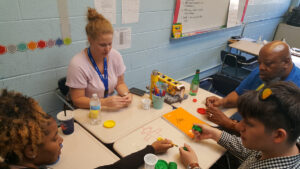How to Differentiate Your Lessons When Tutoring With Saga
November 26, 2018As a Saga Fellow, and to be an effective tutor in general, one of the most important things you can learn is to tailor your instruction to best support the needs of each student. Every student is different, and as a Fellow, it’s important to recognize your students’ entry point in a given lesson, so you can differentiate your lessons and help each student succeed.
Saga Site Director Julie Dziedzic at Sullivan High School in Chicago shared four strategies Saga Fellows use when differentiating their lessons.

1. Set expectations with your students
“When building relationships with your students, you need to toe the line between being a tutor and being a friend. Yes, ask students how they’re doing and learn about their likes and dislikes. But also ask them how they like to learn best. At the end of a visual lesson, for example, ask, ‘How did this work out for you? Did you understand this better than the abstract lesson?’ When you start talking to students about what works and doesn’t work for them, it sets the students’ frame of mind that you are someone who cares about their academic success as much as how the football game or concert was last night. Both are important.”
2. Gauge your students’ interest in learning, and find common ground
“Some students are interested in how they learn and how to do math better. Other students haven’t bought into learning yet. With those students, I coach my tutors to find a common interest and weave that into the lesson. For example, one Fellow was having a hard time reaching a student who was struggling to focus during lessons. I found out they both enjoyed March Madness and suggested they do a bracket together. That was the incentive. After a lesson, they would get to compare brackets following the previous night’s game. What works for one student isn’t going to work with another student.”
Kevin (6th grade Algebra) is always willing to help his partners in a tutorial by breaking down problems, praising them for working hard, and sharing different ways to solve the same problem.

3. Mix it up with different approaches
“Students appreciate variety and novelty. The Saga curriculum provides a good distribution of different ways to deliver a lesson. You can use more of a visual style one time, then more of an abstract style or hands-on activity. I think variety is what keeps math engaging and challenging for the students. I’ve had students that can add, subtract, and divide fractions because they memorized the rules. Because they have such great memories they can do that all day long. But if you ask them to draw a picture of ¾, they’re stumped. Or if you ask kids to multiply 13 x 5, they might do it in the traditional way using an algorithm. But then ask them to do it in another way, 10 x 5 + 3 x 5, that kind of thinking blows their mind. I think when you show students visual ways of doing it, breaking down problems in different ways, it leads to a better conceptual understanding of whatever you’re studying. It helps them build connections.”
4. Challenge different learners to teach each other
“One of the really cool things that can happen during a tutorial session is that every student has a voice. We encourage Fellows to speak less and less, and to have the students make their own sense of the math with as little coaching as possible. The method Saga implements begins with giving students the problem, having them solve it in different ways, and then asking them to explain their reasoning to each other. Sometimes students know stuff but don’t know how to explain it in words. Being able to teach someone else what they know is one of the big goals. We not only want students to do math, but to justify what they did to another person. It’s cool when students see problems in different ways because it hammers home the fact that you can have alternative methods and get the same answer. There’s more than one way to do things.”
Differentiation is just one hallmark of the Saga tutoring model, and a necessary part of ensuring individual student success. Want to discover how you can help to make a difference in the lives of students in Chicago and New York? We still have a few Fellowship opportunities available in Chicago and New York City for the current 2018-19 school year, and the application for the 2019-20 academic year for Chicago and New York City is open now! Learn more about the roles and apply now.
